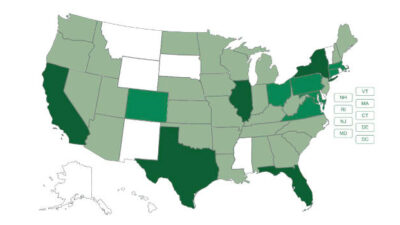Morrissey Goodale is providing A/E leaders with news and perspective on COVID-19 and its impact on the industry. This week, they highlight how geography is a key factor to success and why U.S. companies are moving South.

The business models of iconic industry firms are not tied directly to geography. A powerful mix of their stellar brands and cutting-edge design and/or technical expertise afford them opportunities to design and build facilities and infrastructure anywhere in the world. For all intents and purposes, their business models are agnostic to where their corporate headquarters are located. (Remember corporate headquarters? So 2019!)
However, for most AE firms geography is a primary determinant of success. Location matters. Local knowledge and connections are critical. From planning to permitting to design to construction. From hiring to retention to being part of the community. Local reputation is everything. As one industry CEO puts it “Everything about this industry is regional.”
Beginning in the mid-2000s, the concept of emerging mega-regions underpinned the strategic plans of many ambitious AE firms. Leadership teams planned investments (acquisitions, new offices, key hires) to position themselves to take advantage of market opportunities in these high-density, economically robust regions.
The Great Recession threw a wrench (or a spanner if you’re an anglophile) in the works. The Arizona Sun Corridor, Piedmont Atlantic, Florida and Southern California “sunshine” mega-regions got hammered in the economic meltdown. Their housing bubbles burst, taking their regional economies down harder than those of other mega-regions. Firms that were headquartered in those regions took a beating. Firms that had just recently entered those markets to support their mega-region strategic plans had their balance sheets shredded. Many never recovered after buying at the top of the market.
The AE industry started to rebound from the Great Recession in 2014. Firms in every sector and region of the country for the most part enjoyed a series of consecutive record-breaking years up until 2020 and the arrival of the pandemic. During this six-year recovery (2014 through 2019) the industry once again saw disproportionate investments in the sunshine mega-regions and the Texas Triangle mega-region. Why?
If there’s a nirvana for AE firms – it’s in the South. Long term, the U.S. population is moving there. Buildings and infrastructure investments will follow. Southern states are generally more business friendly. Taxes are generally lower there. All things being equal, it’s easier for an AE firm to grow revenues and earnings in a Southern state than anywhere else in the U.S.
That’s not to say that firms cannot be super successful in other regions. Of course they can. But if your business model depends on geography then it’s better to be in a region that’s growing and business friendly than not – and those are generally in the South. For example, if you’re a transportation engineering firm in the Northeast and you win an IDIQ contract with a state DOT, chances are you’ll never maximize the value of the contract. Compare that with many Southern DOTs where IDIQs more often than not turn quickly into essentially guaranteed fixed fees and with increases in fee value. Or if you’re an employee-owned firm based in a region with declining population then your long-term ownership transition plan is based on finding growth beyond your home area.
And that’s why Southern states have seen disproportionately more M&A activity. From 2017 through 2019, acquisitions in Texas increased by 34% to a nation-leading 35 (almost 3 every month). In Florida, Georgia and the Carolinas over the same period, acquisitions almost doubled to 47 for the year.
Then the pandemic hit and accelerated all the trends in play. The collective big winners? Southern states. Business migration to the South from the high-tax states along the coasts, and the mid-west has picked up pace. Elon Musk is moving there to be closer to the Tesla’s newest Gigafactory. Austin is the hottest housing market in a superhot Sunbelt. Millennials (and every other demographic) are moving to Tennessee, Texas and Florida according to U-Haul. Meanwhile, according to a comprehensive study by Morrissey Goodale on how the pandemic has been impacting the AE industry, Southern states have performed markedly better economically through the pandemic than others. AE deals in Texas hit an all-time high of 37 in 2020 even though the industry M&A essentially shut down from March through June.
One thing that’s of particular interest is the difference in how firms are working in the South compared with their industry peers. In major metros along the West Coast and in the Northeast and Midwest, designers and scientists having been working remotely almost exclusively for the past 10 months. They’ve been working harder than ever, but largely disconnected physically from their peers and clients. As one CEO put it, her firm has “55 satellite offices.” In the South it’s a different dynamic. There are relatively more (masked) employees in offices. There’s more opportunity to gather for socially-distanced outdoor lunches and dinners – critical to building social capital. All-in-all the dynamic among Southern industry firms is a lot closer to “normal” than in other parts of the country. One wonders if firms in the South will have an easier time in maintaining their cultures than their peers in other parts of the country.
Around the country the industry had a banner profit year in 2020. As the vaccines roll out, and the entertainment, hospitality and travel sectors recover and with an infrastructure stimulus plan more likely now than before, there’s every reason to expect that 2021 will be a better year. We’ve proven to be a remarkably resilient (and essential!) industry overall. However, don’t be surprised if in a post-pandemic world we see more AE firms moving to and expanding in the South. We can expect to see more talent chose to move to the South too.
This article originally appeared on Morrissey Goodale’s website. Morrissey Goodale is a CFE Media content partner.



